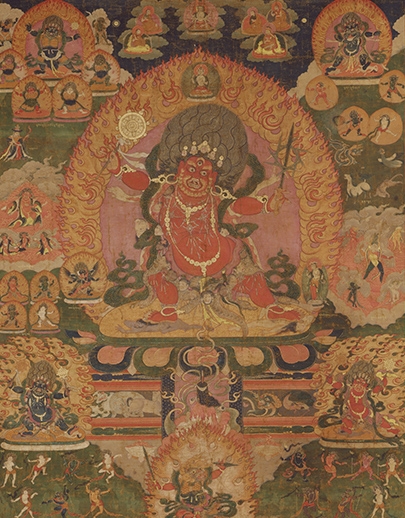
Although Buddhism is the predominant religion in Tibet, other religions are also influential, especially Bon. Bon is often described as the indigenous religion of Tibet, though its own narratives say that it came from the western kingdom of Zhangzhung. From the early days of Buddhism in Tibet, Bon and Buddhism were in competition. Narratives of the rise of Buddhism describe Bon as its persecutor, but Bon itself was marginalized and sometimes persecuted following the rise of Buddhism, especially after the beginning of the second millennium. It had to adapt to survive, and both religions defined themselves in relation to each other. The two religions have similar tantric practices, monasticism, and iconography. Bon coexisted with Buddhism for centuries in some communities, and local painters created works for both religious traditions, drawing on the same visual vocabulary. Still, Bon preserved its distinct identity and retains many unique elements.
Takla Membar, the Flaming Tiger God, is an important deity in Bon, usually employed as a meditational deity. He is also considered a doctrinal weapon because practitioners employ him in meditation against Buddhists whenever the Bon religion is suppressed. This painting contains warlike imagery that expresses his wrathful nature, including a weapon of nine crossed swords that is unique to Bon. The deities of his retinue are clothed with natural elements such as fire, water, clouds, animal skins, and snakes, reflecting the importance of nature to Bon. These motifs may have originated in Tibet or in Central Asia, in keeping with Bon origin narratives.
Come view our Art of the Week in the exhibition Masterworks of Himalayan Art.
C2005.4.4, HAR 65398
- https://dev.rubinmuseum.org/images/content/7230/08.09.19_art_of_the_week__-_takla_membar__zoom.jpg
- https://dev.rubinmuseum.org/images/content/7230/08.09.19_art_of_the_week__-_takla_membar__zoom.jpg

